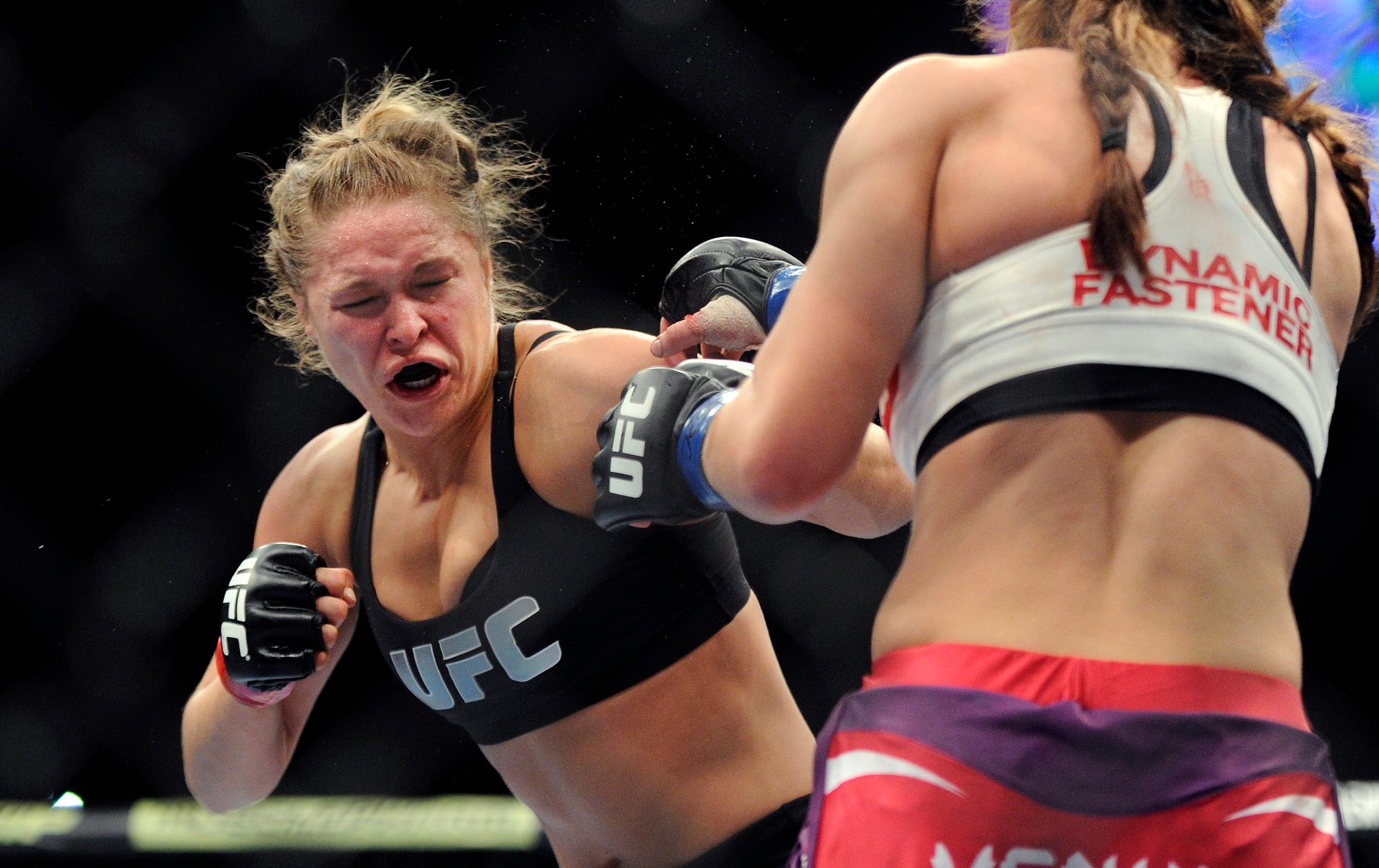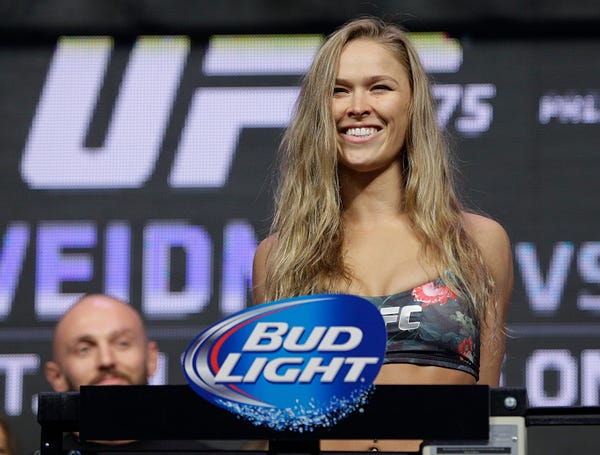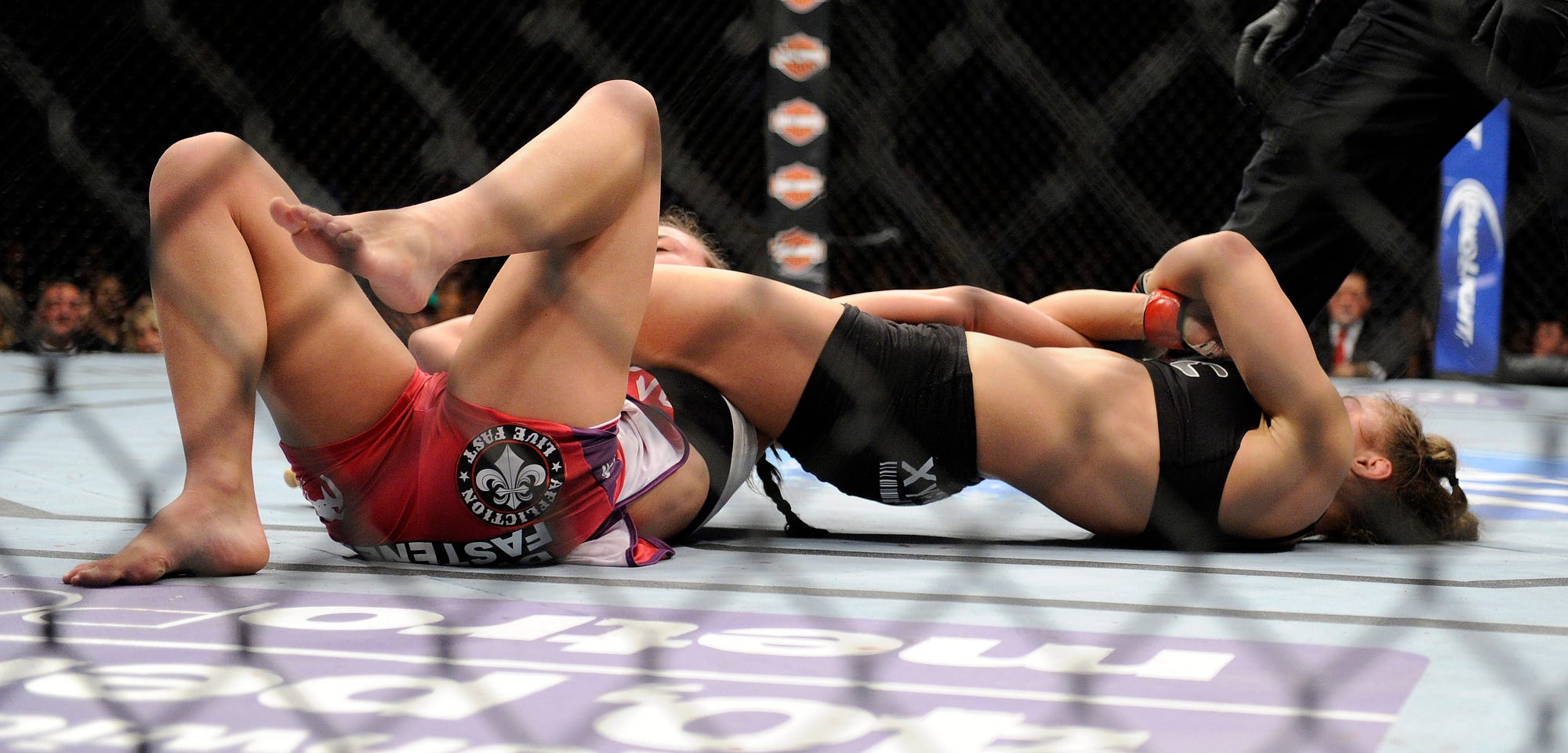Third Wave Feminism’s New Frontier: Mixed Martial Arts? — The Cauldron — Medium
Women fighting inside a cage? The UFC may seem an unlikely place to cite the movement, but the fit is better than you might think.
Time and time again, the question was asked: “When are we going to see women fighters in the Ultimate Fighting Championship?” And time and time again, UFC President Dana White was consistent in his answer: “Never.”
So what happened that changed his mind?
Ronda Rousey happened.
An Olympic Bronze Medalist in Judo at the 2008 Beijing Games, Rousey transitioned to Mixed Martial Arts in 2010 and turned pro in 2011. She quickly made a name for herself by plowing through the competition in thrilling fashion, rarely needing more than 30 seconds to finish her opponent. By any metric, she’s a natural fighter, full of fists and hips and pure meanness. She’s driven, competitive, smart, tough.
And undefeated.
Within a year of turning pro, she dropped from 145 pounds to 135 and captured the Strikeforce Women’s Bantamweight Championship. She successfully defended that Championship later in 2012, and then, in November of that year, Dana White signed her to the UFC and named her their Women’s Bantamweight Champion. Truthfully, though, it took more than just solid technique and an impeccable record to change White’s mind about women in the UFC.
Professional female MMA fighters are nothing new. In Japan, they were fighting as early as the mid-1990s. Smackgirl was formed in 2001. For several years, that was the only major organization that held women’s bouts, and only in Japan. For the next decade across most of the world, women were relegated to smaller, local promotions.
The mid-2000s were a watershed moment for women’s MMA. Strikeforce introduced women’s matches in 2006, with EliteXC and Bellator MMA following suit in 2007 and 2010, respectively. One of White’s main objections to women fighters in the UFC had been he perceived as a lack of depth in the field. Not enough women fighters were skilled or ambitious enough for him to join the UFC, he thought, given that his was an international organization considered by most to be MMA’s “Big League.” By 2011, that argument was becoming less and less compelling.
Former Strikeforce CEO Scott Coker, a long-time advocate for women MMA fighters, invited White to watch Rousey’s title defense against Sarah Kaufman in August 2012. There were two other women’s fights on the card that night, including the former Champion Miesha Tate against early trailblazer and female star Julie Kedzie. For three rounds they went back and forth in an epic struggle for cage dominance. Tate was finally able to get the submission, and White — as he often does — took to Twitter with barely-contained excitement. He called Tate “tough as nails.” Rousey’s fight, however, took White to another place entirely, and in the span of a few hours, he went from hesitant skeptic to enthusiastic convert.
While the Tate/Kedzie fight impressed and excited White, he recognized something else in Rousey. She had something more intense, more focused, and more technically sound. He has called her a “beast” and a “rock star,” and declared that he “wouldn’t have [brought women into the UFC] without Ronda … she’s the one that when I met her I said, this chick is insanely competitive and just a different animal.”
As we all know, White was (eventually) right.
Rousey is nightmare fuel for any woman who steps into the cage without having adequately prepared for her. And none of them have adequately prepared for her. Sometimes they know that walking in, and it is written all over their faces. Sometimes it is made abundantly clear as soon as the bell rings. Their carefully laid plans — keep her on her feet, stuff her takedowns, defend against the Arm Bar of Death — evaporate with one perfectly crafted hip toss. And then, in the words of ring-side announcer Mike Goldberg, “it’s all over!”

At 28, Rousey is in the prime of her career. Her fights have never gone to a decision, and she has only needed multiple rounds for one fighter — Miesha Tate.
Her response to “allowing” Tate to take her deep into the third round was to train even harder for her next title defense. That hard work paid off. She only needed 16 seconds to defeat Alexis Davis last July at UFC 175 in Las Vegas. And she didn’t need her signature move to do it.
Unfortunately, this means we never get to see much of her or what she is truly capable of inside the Octagon. No one (yet) has been able to give her that much of a challenge. So how can we know how great she really is? What, exactly, is so special about “Rowdy” Ronda Rousey?
First, Rousey understands her place in this sport, and her place in its history. She’s breaking barriers, chipping away at prejudices, and blazing a trail for other women with Octagon dreams to follow. She knows exactly how powerful she is, and she has the smarts and the confidence to capitalize on it. She is no one’s token and she is not being exploited.

She also has the “It Factor” that is sadly lacking across the rest of the UFC. She has the skills and the toughness, sure. But she is also attractive and photogenic, well-spoken and charismatic. Her appeal goes beyond the Octagon all the way to Hollywood.
To many outside observers, the UFC has historically been a sport populated with dim-witted gym rats, humble NCAA wrestlers, and shy martial artists. The sports’ roster of male fighters that play as rough Bluto-types or droning bores doesn’t help matters; neither are compelling, nor do they inspire the casual fan to get excited or follow the sport or its personalities more closely.
And while image alone shouldn’t be the UFC’s priority, it is nevertheless crucial in cultivating new fanbases—particularly across gender demographics—to compete with the other major professional leagues. Rousey has the ability to transcend the sport, an absolutely critical and vital trait.
“There was just a story done by Fox where girls were taking girls-trips to Vegas for fights. Whenever you go to any of the big fights, there’s girls there with their husbands or their boyfriends or whatever but there’s a lot of girls there either by themselves or with friends. It’s been amazing how fast our female fanbase has grown. We didn’t see that coming.” —Dana White
The UFC has always had female fans. The latest from an independent marketing survey put that number around 27 percent — well below those of Major League baseball (41 percent) and the NFL (40 percent). But even before the introduction of women fighters, the female fanbase was growing. In 2011, White claimed the female fanbase was somewhere around 45 percent and Canada.com puts the number at 40 percent. Those numbers are probably a little high, and the self-reporting surveys may be a little low. It still isn’t very mainstream or socially acceptable for a woman to admit liking mixed martial arts, but the female viewers that are watching have attention to give and money to spend.
Because of White’s signing Rousey and then 30 other women to the UFC Women’s Bantamweight roster, female viewers now have fighters with whom they can more closely relate. And in terms of attracting, engaging, and keeping fans, that matters — a lot.
The women who find their way to MMA are rich, poor, gay, straight, white, black, Hispanic, Asian, multi-racial, and transgender. They come from suburban neighborhoods in the American Midwest, the streets of Glasgow, expat communities in Thailand, and the war-torn Middle East. They are community activists and college professors, military veterans and Olympic athletes. They are single mothers and child-free women; divorced, married, and everything in between. They come from everywhere, and they look like all of us.
Coincidentally, the population of female MMA fans is probably not at all different from the type of women whom Third-Wave Feminism seeks to engage, empower, and learn from. As the last two decades have seen the rise of women fighters in the MMA, so has the emergence of Third-Wave Feminism gone mainstream. The two go more hand-in-hand than one might think.
Third-Wave Feminism is not your mother’s college campus ERA rally, anti-strip club protest, or bra-burning demonstration kind of movement. It does not look at the accomplishments of primarily white, educated, middle class women like Gloria Steinem or Hillary Rodham-Clinton and say, “thanks for everything! There’s nothing left to do here.”
Far from it, and rightly so.
Third-Wave Feminism rose up in the 1990s in response to the Second-Wave Feminism of the 1960s and 70s and what many women saw as increased orthodoxy and strict interpretations of what feminism was and wasn’t. It challenged how women who called themselves Feminists (with a capital F) “ought” to behave and think. These new feminists sought to distance themselves from what they regarded as a movement out of touch with the majority of modern women and the diversity of their dreams and goals.
It acknowledged and supported — and still does — the tomboy, the Riot Grrrl, the scientist, the business executive, the stay at home mom, and the sex worker—all with equal regard. It does not scorn the “male gaze.” It recognizes that binary gender norms hurt everyone, including men and boys.
It is through this understanding of what feminism is that we may see women in the UFC as something to celebrate. (And yes, there is a long way to go. Endorsement deals and exposure for most women fighters unsurprisingly lags far behind their male counterparts.) It’s been a long time since Title IX was signed by President Nixon, but over the last 40+ years, women’s athletics have gained a foothold and a level of prestige.
For the most part, this progress has been marked in non-contact sports such as softball and volleyball, and non-team sports such as tennis and golf. Like the early feminist movements, the denizens of these sports are often suburban, middle-class, and white. These advancements are also usually in connection with NCAA sports, so these women have the advantage of being college-educated. And even though things can get a bit chippy on the basketball court or the soccer pitch, they are markedly less violent than full-contact sports such as football or hockey. In short, we seem to be okay with moving toward a level playing field when it comes to more traditionally acceptable female sports.
Third Wave Feminism acknowledges that empowerment and equality means drastically different things for very different women in today’s society. It’s not one-size-fits-all progression. For one woman it means a college degree, for another a job promotion. For Rousey (and her peers), it is to be taken seriously and valued in a male dominated sport and industry that allows them to punch, kick, bleed, and bruise.

Last fall, the 20th season of The Ultimate Fighter (TUF) commenced, which, for the first time ever, was all female. Also for the first time, a champion was crowned at the end of the season.
TUF, the UFC’s answer to competition-based reality programming, long ago established itself as a kind of “development program” for the UFC. They brought in promising, young, up-and-comers with little to no professional fight experience. However, the 16 women featured this past season are all well-established in professional MMA.
Many of the contestants were brought in from the Invicta Fighting Championships, an organization founded in 2012 exclusively for female fighters, including its former Strawweight Champion, Carla Esparza. In total, White and the UFC signed eleven Invicta fighters to UFC contracts. Eight of them competed in TUF20, and Esparza ultimately prevailed, submitting Rose Namajunas in the third round.
All 16 women on TUF20 — including the other eight women who were unsigned and made the show through audition — have already earned the status of UFC fighters. In past seasons, winning a spot on the program did not guarantee a contract. This time, in an effort to establish a new weight class in one fell swoop, all the contestants were signed. During the premier episode, White said women in the UFC were “no longer an experiment.” In everything he has said and done regarding women fighters over the past couple years, White acts like a man who has never been so happy to be so wrong.
“[TUF 20 is] the most important season we’ve ever done.” —Dana White
The establishment of a second weight class also shows that women in the UFC are here to stay. Unlike other female-focused organizations, UFC limited women fighters to the Bantamweight. Through this expansion, White is signaling his confidence in the strength, appeal, and success of female fighters and that their incorporation is more than just a token.
But it’s also pretty clear that White, along with all the female fighters, acknowledges and appreciates this moment in history. He is very aware that what he’s doing is bold and disruptive. When the announcement of an all-female season of TUF was made, White had this to say: “The fans like it, I’m thrilled with it, and we’re going to dive into the 115-pound division…[w]e’re invested, we’re in, as far as the women go.”
White’s decision was controversial. MMA in general has no shortage of detractors who condemn it as barbaric and ultra-violent. For example, MMA has never been sanctioned in New York. Opponents have successfully lobbied an across-the-board ban for years now, with the state’s chapter of the National Organization for Women a particularly vocal adversary.
Much of the argument against the sport centers on the violence and it’s (unproven) connection with youth and domestic violence. Women, of course, are continually propped up as victims, which, for Third-Wave Feminism, is problematic. Martial arts coach and feminist scholar, L.A. Jennings, addressed this particular conundrum brilliantly, by illustrating the current tension within competing feminist views. There is the “white corporate feminism” of Sheryl Sandberg and the women of New York’s NOW on one side, and a more intersectional approach to Third-Wave Feminism on the other. Modern proponents of the latter view typically reject social norms of what it means to be a woman — feminine, agreeable, polite — norms which even other self-described feminists often hold up as still being ideal.
So while female MMA fighters may have a long way to go before they’re heralded by the majority of modern and early-era feminists, they are being respected and included in an arena which matters most to them—the male dominated-industry they work in.
Informed by an earlier feminist worldview, the violence of male fighters and the hyper-masculinity it glorifies is unsavory. To watch two women enter a cage and beat each other bloody is something else entirely. It flies in the face of everything we have been taught and socialized to believe women “should” do and be. For some, it’s far too objectionable. Others cheer on the women in MMA and see Third-Wave Feminism in glorious, empowered, hyper-physical action. And it’s thrilling. Because some of us aren’t content to just “Lean In;” some of us would rather kick ass.
